An Assessment of Computational Fluid Dynamics as a Tool to Aid the Design of the HCMR-Artificial-ReefsTM Diving Oasis in the Underwater Biotechnological Park of Crete
Abstract
1. Introduction
2. Materials and Methods
2.1. Study Area
2.2. Constructing and Deploying the HCMR Artificial Reefs
2.3. Creating the Computational Grid for 3-D Demonstration and Computational Fluid Dynamics (CFD) Analysis
3. Results
3.1. Monitoring of the Deployed AR
3.2. Computational Fluid Dynamics (CFD) Simulation of a Single AR Unit
3.3. Computational Fluid Dynamics (CFD) Simulation of an Artificial Reef (AR) cluster
4. Discussion
5. Conclusions
Author Contributions
Funding
Acknowledgments
Conflicts of Interest
Appendix A
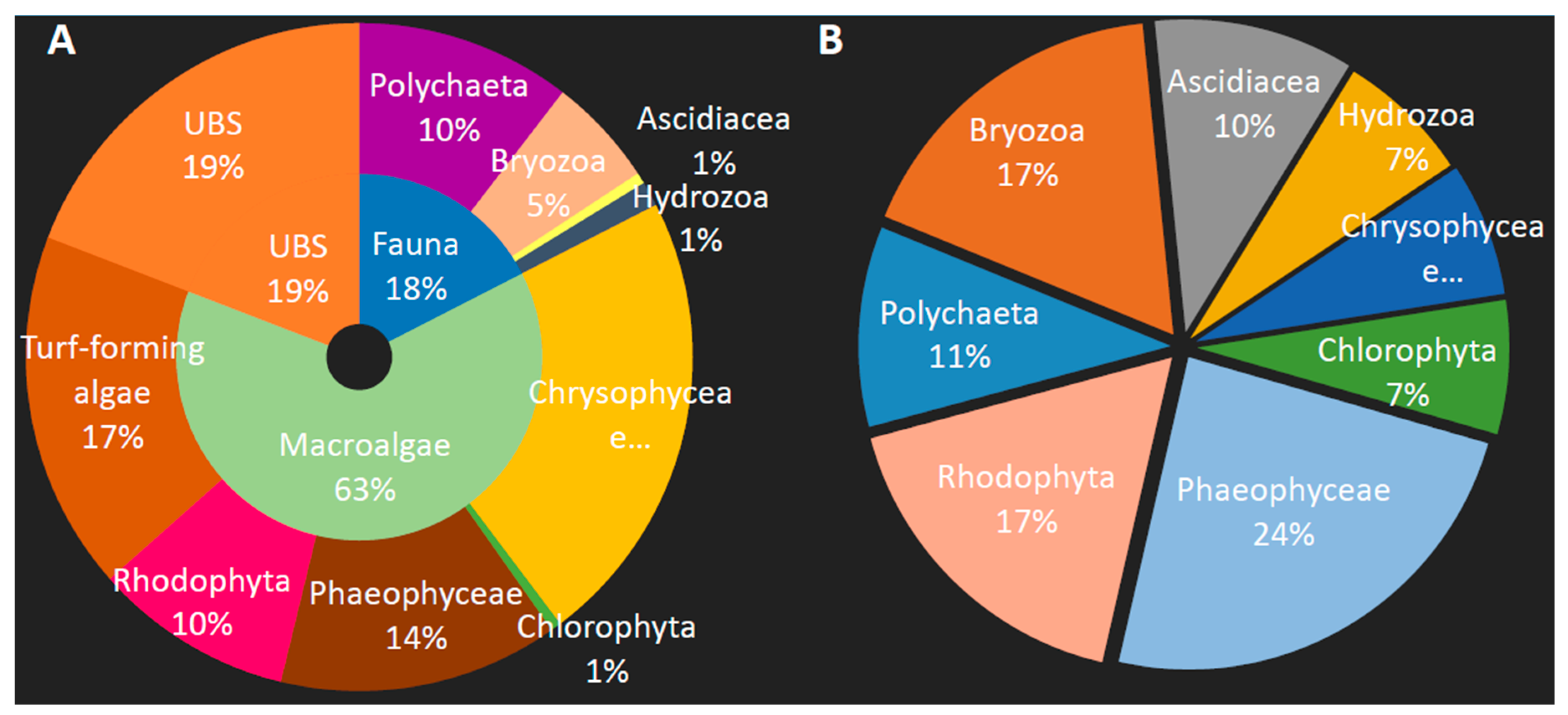
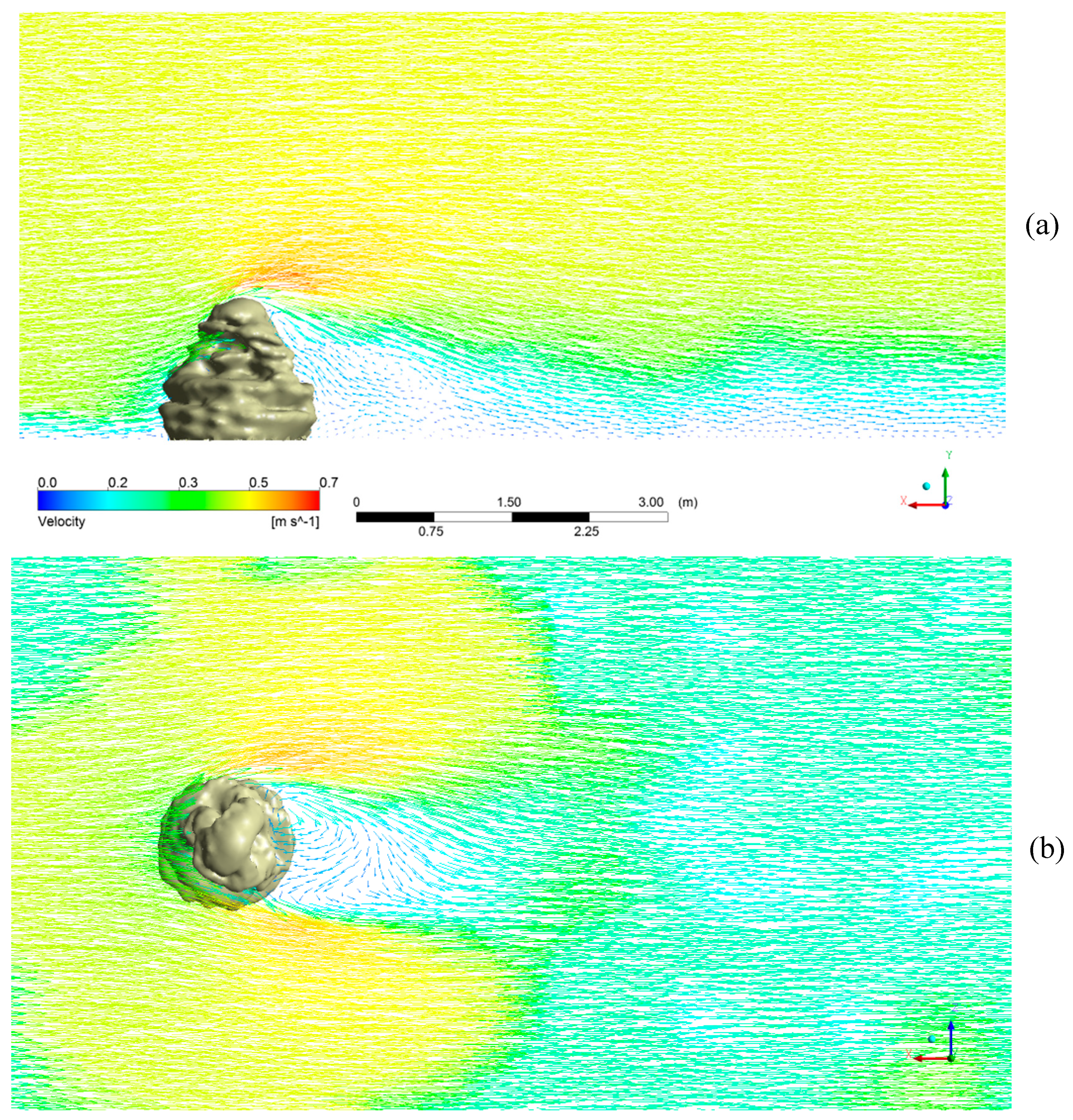
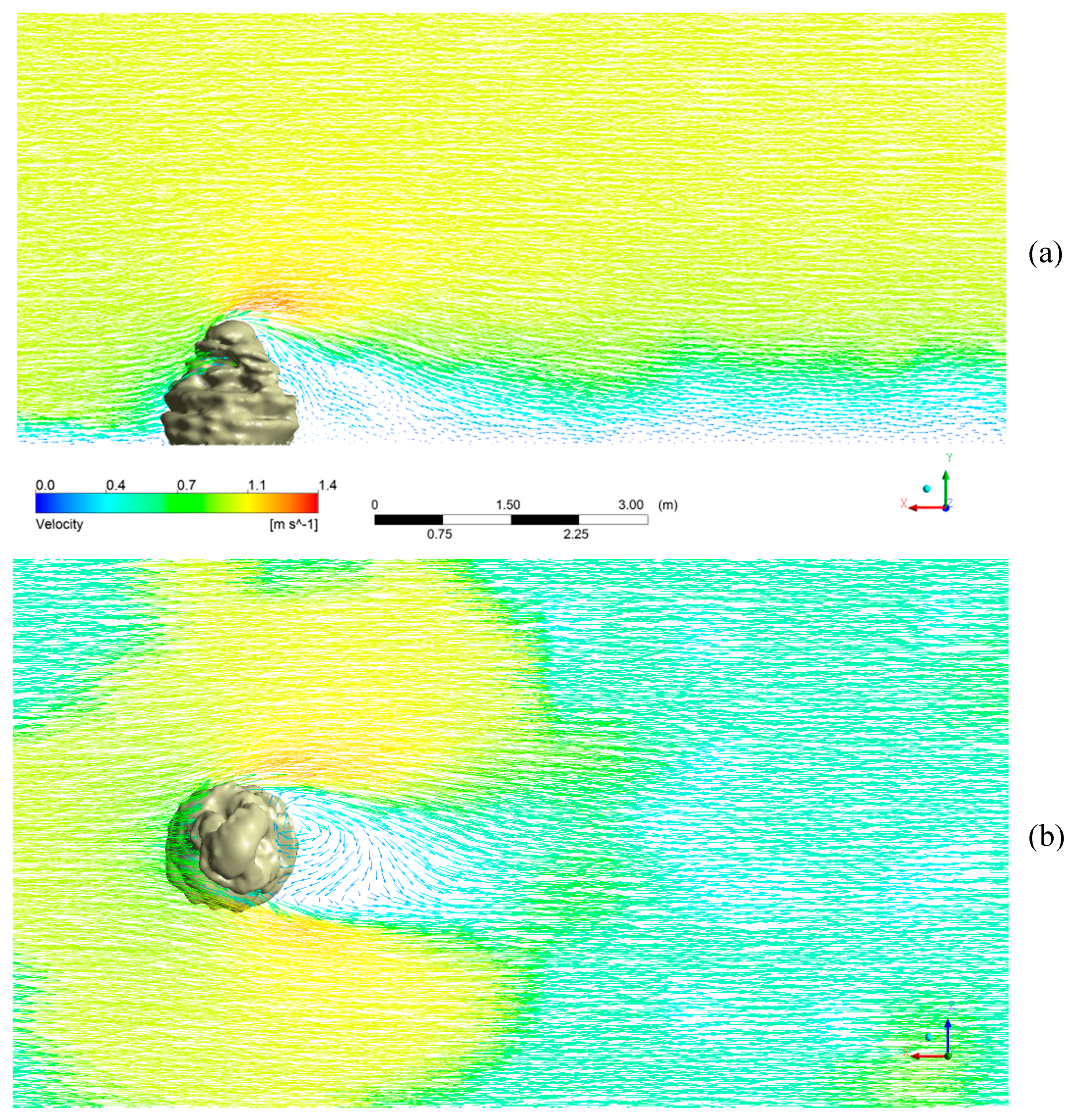
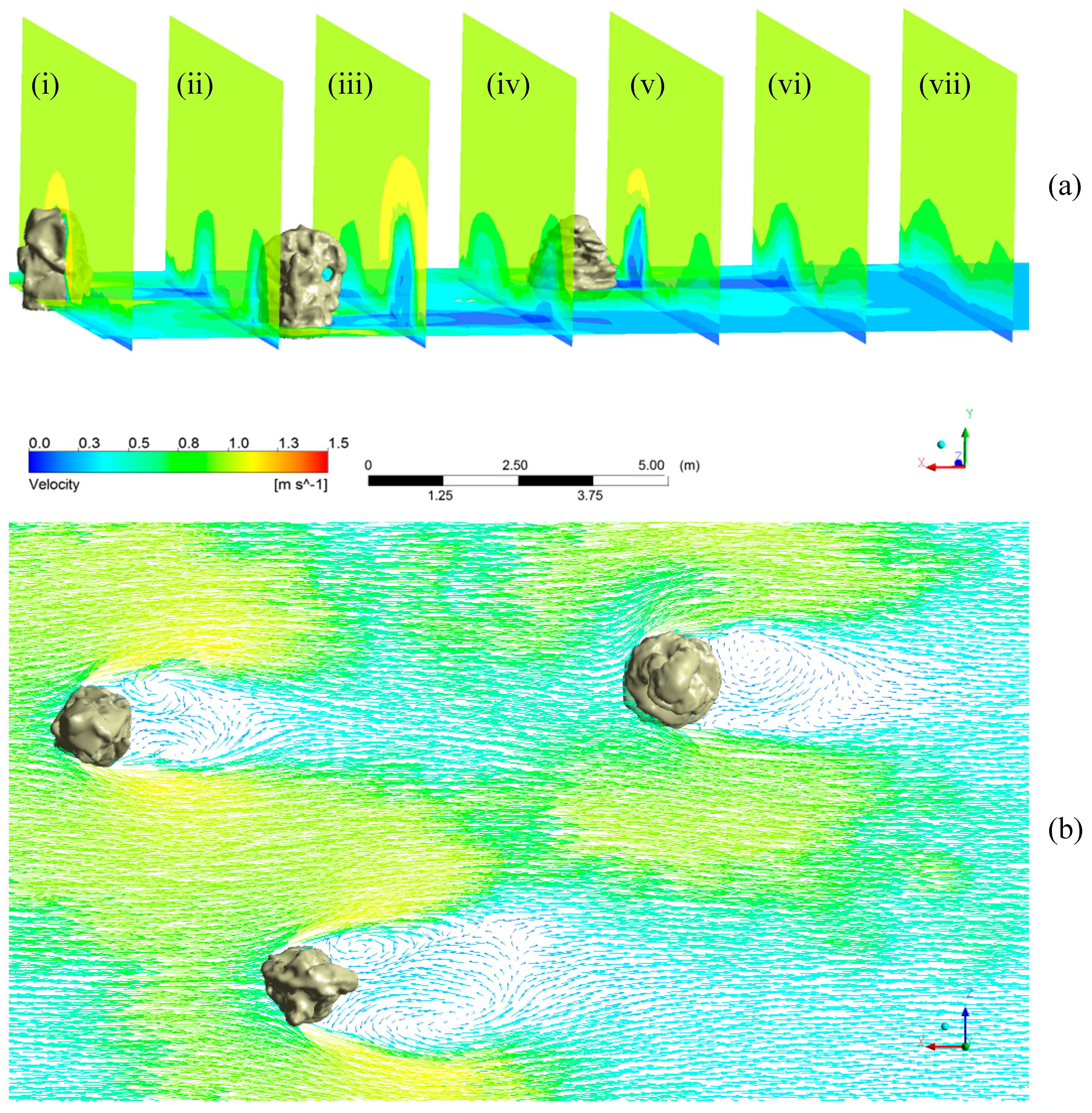
References
- European Parliament. The Impact of Tourism on Coastal Areas: Regional Development Aspects, Study of Policy Department B: Structural and Cohesion Policies; European Parliament: Brussels, Belgium, 2008. [Google Scholar]
- FAO. The State of World Fisheries and Aquaculture. Meeting the Sustainable Development Goals; FAO: Rome, Italy, 2018. [Google Scholar]
- Ishizu, M.; Miyazawa, Y.; Tsunoda, T.; Guo, X. Development of a Biogeochemical and Carbon Model Related to Ocean Acidification Indices with an Operational Ocean Model Product in the North Western Pacific. Sustainability 2019, 11, 2677. [Google Scholar] [CrossRef]
- Nilsson, J.A.; Fulton, E.A.; Johnson, C.R.; Haward, M. How to Sustain Fisheries: Expert Knowledge from 34 Nations. Water 2019, 11, 213. [Google Scholar] [CrossRef]
- Vergés, A.; Steinberg, P.D.; Hay, M.E.; Poore, A.G.B.; Campbell, A.H.; Ballesteros, E.; Heck, K.L.; Booth, D.J.; Coleman, M.A.; Feary, D.A.; et al. The tropicalization of temperate marine ecosystems: Climate-mediated changes in herbivory and community phase shifts. Proc. R. Soc. B 2014, 281, 20140846. [Google Scholar] [CrossRef] [PubMed]
- Wongthong, P.; Harvey, N. Integrated coastal management and sustainable tourism: A case study of the reef-based SCUBA dive industry from Thailand. Ocean Coast. Manag. 2014, 95, 138–146. [Google Scholar] [CrossRef]
- Mitsch, W.J. When will ecologists learn engineering and engineers learn ecology? Ecol. Eng. 2014, 65, 9–14. [Google Scholar] [CrossRef]
- International Maritime Organization. Guidelines for the Placement of Artificial Reefs: London Convention and Protocol/UNEPI; International Maritime Organization: London, UK, 2009. [Google Scholar]
- Wetzel, M.A.; Scholle, J.; Teschke, K. Artificial structures in sediment-dominated estuaries and their possible influences on the ecosystem. Mar. Environ. Res. 2014, 99, 125–135. [Google Scholar] [CrossRef] [PubMed]
- Ido, S.; Shimrit, P.-F. Blue is the new green—Ecological enhancement of concrete based coastal and marine infrastructure. Ecol. Eng. 2015, 84, 260–272. [Google Scholar] [CrossRef]
- Noh, J.; Ryu, J.; Lee, D.; Khim, J.S. Distribution characteristics of the fish assemblages to varying environmental conditions in artificial reefs of the Jeju Island, Korea. Mar. Pollut. Bull. 2017, 118, 388–396. [Google Scholar] [CrossRef]
- Dos Santos, L.N.; Brotto, D.S.; Zalmon, I.R. Fish responses to increasing distance from artificial reefs on the Southeastern Brazilian Coast. J. Exp. Mar. Biol. Ecol. 2010, 386, 54–60. [Google Scholar] [CrossRef]
- Cardoso, A.P.L.R.; Matos, M.R.S.B.C.; Rosa, R.S.; Alvarado, F.; Medeiros, A.P.M.; Santos, B.A. Increased fish diversity over day and night in structurally complex habitats of artificial reefs. J. Exp. Mar. Biol. Ecol. 2020, 522, 151244. [Google Scholar] [CrossRef]
- Komyakova, V.; Swearer, S.E. Contrasting patterns in habitat selection and recruitment of temperate reef fishes among natural and artificial reefs. Mar. Environ. Res. 2019, 143, 71–81. [Google Scholar] [CrossRef] [PubMed]
- Pickering, H.; Whitmarsh, D. Artificial reefs and fisheries exploitation: A review of the ‘attraction versus production’ debate, the influence of design and its significance for policy. Fish. Res. 1997, 31, 39–59. [Google Scholar] [CrossRef]
- Abecasis, D.; Bentes, L.; Lino, P.G.; Santos, M.N.; Erzini, K. Residency, movements and habitat use of adult white seabream (Diplodus sargus) between natural and artificial reefs. Estuar. Coast. Shelf Sci. 2013, 118, 80–85. [Google Scholar] [CrossRef]
- Paxton, A.B.; Revels, L.W.; Rosemond, R.C.; Van Hoeck, R.V.; Lemoine, H.R.; Taylor, J.C.; Peterson, C.H. Convergence of fish community structure between a newly deployed and an established artificial reef along a five-month trajectory. Ecol. Eng. 2018, 123, 185–192. [Google Scholar] [CrossRef]
- Smith, J.A.; Lowry, M.B.; Suthers, I.M. Fish attraction to artificial reefs not always harmful: A simulation study. Ecol. Evol. 2015, 5, 4590–4602. [Google Scholar] [CrossRef] [PubMed]
- Ajemian, M.J.; Wetz, J.J.; Shipley-Lozano, B.; Shively, J.D.; Stunz, G.W. An Analysis of Artificial Reef Fish Community Structure along the Northwestern Gulf of Mexico Shelf: Potential Impacts of “Rigs-to-Reefs” Programs. PLoS ONE 2015, 10, e0126354. [Google Scholar] [CrossRef]
- Polovina, J.J.; Sakai, I. Impacts of Artificial Reefs on Fishery Production in Shimamaki, Japan. Bull. Mar. Sci. 1989, 44, 8. [Google Scholar]
- Cenci, E.; Pizzolon, M.; Chimento, N.; Mazzoldi, C. The influence of a new artificial structure on fish assemblages of adjacent hard substrata. Estuar. Coast. Shelf Sci. 2011, 91, 133–149. [Google Scholar] [CrossRef]
- Loke, L.H.L.; Ladle, R.J.; Bouma, T.J.; Todd, P.A. Creating complex habitats for restoration and reconciliation. Ecol. Eng. 2015, 77, 307–313. [Google Scholar] [CrossRef]
- Moschella, P.S.; Abbiati, M.; Åberg, P.; Airoldi, L.; Anderson, J.M.; Bacchiocchi, F.; Bulleri, F.; Dinesen, G.E.; Frost, M.; Gacia, E.; et al. Low-crested coastal defence structures as artificial habitats for marine life: Using ecological criteria in design. Coast. Eng. 2005, 52, 1053–1071. [Google Scholar] [CrossRef]
- Langhamer, O. Artificial Reef Effect in relation to Offshore Renewable Energy Conversion: State of the Art. Sci. World J. 2012, 2012, 1–8. [Google Scholar] [CrossRef] [PubMed]
- Riera, E.; Lamy, D.; Goulard, C.; Francour, P.; Hubas, C. Biofilm monitoring as a tool to assess the efficiency of artificial reefs as substrates: Toward 3D printed reefs. Ecol. Eng. 2018, 120, 230–237. [Google Scholar] [CrossRef]
- Blakeway, D.; Byers, M.; Stoddart, J.; Rossendell, J. Coral Colonisation of an Artificial Reef in a Turbid Nearshore Environment, Dampier Harbour, Western Australia. PLoS ONE 2013, 8, e75281. [Google Scholar] [CrossRef] [PubMed]
- Ng, C.S.L.; Lim, S.C.; Ong, J.Y.; Teo, L.M.S.; Chou, L.M.; Chua, K.E.; Tan, K.S. Enhancing the biodiversity of coastal defence structures: Transplantation of nursery-reared reef biota onto intertidal seawalls. Ecol. Eng. 2015, 82, 480–486. [Google Scholar] [CrossRef]
- Layman, C.A.; Allgeier, J.E.; Montaña, C.G. Mechanistic evidence of enhanced production on artificial reefs: A case study in a Bahamian seagrass ecosystem. Ecol. Eng. 2016, 95, 574–579. [Google Scholar] [CrossRef]
- Perkol-Finkel, S.; Shashar, N.; Benayahu, Y. Can artificial reefs mimic natural reef communities? The roles of structural features and age. Mar. Environ. Res. 2006, 61, 121–135. [Google Scholar] [CrossRef]
- Wu, Z.; Tweedley, J.R.; Loneragan, N.R.; Zhang, X. Artificial reefs can mimic natural habitats for fish and macroinvertebrates in temperate coastal waters of the Yellow Sea. Ecol. Eng. 2019, 139, 105579. [Google Scholar] [CrossRef]
- Van Treeck, P.; Schuhmacher, H. Mass Diving Tourism – A New Dimension Calls for New Management Approaches. Mar. Pollut. Bull. 1999, 37, 499–504. [Google Scholar] [CrossRef]
- Zakai, D.; Chadwick-Furman, N.E. Impacts of intensive recreational diving on reef corals at Eilat, northern Red Sea. Biol. Conserv. 2002, 105, 179–187. [Google Scholar] [CrossRef]
- Terrón-Sigler, A.; León-Muez, D.; Peñalver-Duque, P.; Torre, F.E. The effects of SCUBA diving on the endemic Mediterranean coral Astroides calycularis. Ocean Coast. Manag. 2016, 122, 1–8. [Google Scholar] [CrossRef]
- Toyoshima, J.; Nadaoka, K. Importance of environmental briefing and buoyancy control on reducing negative impacts of SCUBA diving on coral reefs. Ocean Coast. Manag. 2015, 116, 20–26. [Google Scholar] [CrossRef]
- Kirkbride-Smith, A.E.; Wheeler, P.M.; Johnson, M.L. The relationship between diver experience levels and perceptions of attractiveness of artificial reefs—Examination of a potential management tool. PLoS ONE 2013, 8, e68899. [Google Scholar] [CrossRef] [PubMed]
- Belhassen, Y.; Rousseau, M.; Tynyakov, J.; Shashar, N. Evaluating the attractiveness and effectiveness of artificial coral reefs as a recreational ecosystem service. J. Environ. Manag. 2017, 203, 448–456. [Google Scholar] [CrossRef] [PubMed]
- Polak, O.; Shashar, N. Can a small artificial reef reduce diving pressure from a natural coral reef? Lessons learned from Eilat, Red Sea. Ocean Coast. Manag. 2012, 55, 94–100. [Google Scholar] [CrossRef]
- Tynyakov, J.; Rousseau, M.; Chen, M.; Figus, O.; Belhassen, Y.; Shashar, N. Artificial reefs as a means of spreading diving pressure in a coral reef environment. Ocean Coast. Manag. 2017, 149, 159–164. [Google Scholar] [CrossRef]
- Nakamura, M. Evolution of Artificial Fishing Reef Concepts in Japan. 8. Bull. Mar. Sci. 1985, 37, 271–278. [Google Scholar]
- Baine, M. Artificial reefs: A review of their design, application, management and performance. Ocean Coast. Manag. 2001, 44, 241–259. [Google Scholar] [CrossRef]
- Pitcher, T.J.; Seaman Jr, W. Petrarch’s Principle: How protected human-made reefs can help the reconstruction of fisheries and marine ecosystems. Fish Fish. 2000, 1, 73–81. [Google Scholar] [CrossRef]
- Lima, J.S.; Zalmon, I.R.; Love, M. Overview and trends of ecological and socioeconomic research on artificial reefs. Mar. Environ. Res. 2019, 145, 81–96. [Google Scholar] [CrossRef]
- Dafforn, K.A.; Mayer-Pinto, M.; Morris, R.L.; Waltham, N.J. Application of management tools to integrate ecological principles with the design of marine infrastructure. J. Environ. Manag. 2015, 158, 61–73. [Google Scholar] [CrossRef]
- Ruiz-Frau, A.; Possingham, H.P.; Edwards-Jones, G.; Klein, C.J.; Segan, D.; Kaiser, M.J. A multidisciplinary approach in the design of marine protected areas: Integration of science and stakeholder based methods. Ocean Coast. Manag. 2015, 103, 86–93. [Google Scholar] [CrossRef]
- Naylor, L.A.; Coombes, M.A.; Venn, O.; Roast, S.D.; Thompson, R.C. Facilitating ecological enhancement of coastal infrastructure: The role of policy, people and planning. Environ. Sci. Policy 2012, 22, 36–46. [Google Scholar] [CrossRef]
- Claudet, J.; Pelletier, D. Marine protected areas and artificial reefs: A review of the interactions between management and scientific studies. Aquat. Living Resour. 2004, 17, 129–138. [Google Scholar] [CrossRef]
- Lai, S.; Loke, L.H.L.; Hilton, M.J.; Bouma, T.J.; Todd, P.A. The effects of urbanisation on coastal habitats and the potential for ecological engineering: A Singapore case study. Ocean Coast. Manag. 2015, 103, 78–85. [Google Scholar] [CrossRef]
- Tan, W.-J.; Yang, C.-F.; Château, P.-A.; Lee, M.-T.; Chang, Y.-C. Integrated coastal-zone management for sustainable tourism using a decision support system based on system dynamics: A case study of Cijin, Kaohsiung, Taiwan. Ocean Coast. Manag. 2018, 153, 131–139. [Google Scholar] [CrossRef]
- Perkol-Finkel, S.; Hadary, T.; Rella, A.; Shirazi, R.; Sella, I. Seascape architecture—Incorporating ecological considerations in design of coastal and marine infrastructure. Ecol. Eng. 2018, 120, 645–654. [Google Scholar] [CrossRef]
- Zhao, M.; Cheng, L.; Zang, Z. Experimental and numerical investigation of local scour around a submerged vertical circular cylinder in steady currents. Coast. Eng. 2010, 57, 709–721. [Google Scholar] [CrossRef]
- Yun, D.-H.; Kim, Y.-T. Experimental study on settlement and scour characteristics of artificial reef with different reinforcement type and soil type. Geotext. Geomembr. 2018, 46, 448–454. [Google Scholar] [CrossRef]
- Kim, H.S.; Kim, C.G.; Na, W.B.; Kim, J.K. Chemical degradation characteristics of reinforced concrete reefs in South Korea. Ocean Eng. 2008, 35, 738–748. [Google Scholar] [CrossRef]
- Xu, Q.; Ji, T.; Yang, Z.; Ye, Y. Steel rebar corrosion in artificial reef concrete with sulphoaluminate cement, sea water and marine sand. Constr. Build. Mater. 2019, 227, 116685. [Google Scholar] [CrossRef]
- Liu, Z.; He, X.; Fan, J.; Zhou, C. Study on the Softening Mechanism and Control of Red-Bed Soft Rock under Seawater Conditions. JMSE 2019, 7, 235. [Google Scholar] [CrossRef]
- Düzbastılar, F.O.; Şentürk, U. Determining the weights of two types of artificial reefs required to resist wave action in different water depths and bottom slopes. Ocean Eng. 2009, 36, 900–913. [Google Scholar] [CrossRef]
- Ranasinghe, R.; Turner, I.L. Shoreline response to submerged structures: A review. Coast. Eng. 2006, 53, 65–79. [Google Scholar] [CrossRef]
- Kim, D.; Woo, J.; Yoon, H.-S.; Na, W.-B. Efficiency, tranquillity and stability indices to evaluate performance in the artificial reef wake region. Ocean Eng. 2016, 122, 253–261. [Google Scholar] [CrossRef]
- Woo, J.; Kim, D.; Yoon, H.-S.; Na, W.-B. Characterizing Korean general artificial reefs by drag coefficients. Ocean Eng. 2014, 82, 105–114. [Google Scholar] [CrossRef]
- Wang, G.; Wan, R.; Wang, X.; Zhao, F.; Lan, X.; Cheng, H.; Tang, W.; Guan, Q. Study on the influence of cut-opening ratio, cut-opening shape, and cut-opening number on the flow field of a cubic artificial reef. Ocean Eng. 2018, 162, 341–352. [Google Scholar] [CrossRef]
- Liu, Y.; Dong, G.; Zhao, Y.; Guan, C.; Li, Y. The Investigation of the Hydrodynamics of an Artificial Reef. In Aquaculture and the Environment—A Shared Destiny; Sladonja, B., Ed.; InTech: Rijeka, Croatia, 2011; ISBN 978-953-307-749-9. [Google Scholar]
- Liu, Y.; Zhao, Y.; Dong, G.; Guan, C.; Cui, Y.; Xu, T.-J. A study of the flow field characteristics around star-shaped artificial reefs. J. Fluids Struct. 2013, 39, 27–40. [Google Scholar] [CrossRef]
- Jiang, Z.; Liang, Z.; Zhu, L.; Liu, Y. Numerical simulation of effect of guide plate on flow field of artificial reef. Ocean Eng. 2016, 116, 236–241. [Google Scholar] [CrossRef]
- Yoon, H.-S.; Kim, D.; Na, W.-B. Estimation of effective usable and burial volumes of artificial reefs and the prediction of cost-effective management. Ocean Coast. Manag. 2016, 120, 135–147. [Google Scholar] [CrossRef]
- Zhen-qing, M. Effects of water-depth on hydrodynamic force of artificial reef. J. Hydrodyn. 2007, 19, 372–377. [Google Scholar]
- Liu, T.-L.; Su, D.-T. Numerical analysis of the influence of reef arrangements on artificial reef flow fields. Ocean Eng. 2013, 74, 81–89. [Google Scholar] [CrossRef]
- Sous, D. A Numerical Assessment of Artificial Reef Pass Wave-Induced Currents as a Renewable Energy Source. JMSE 2019, 7, 284. [Google Scholar] [CrossRef]
- Hsui, C.-Y.; Wang, C.-C. Synergy between fractal dimension and lacunarity index in design of artificial habitat for alternative SCUBA diving site. Ecol. Eng. 2013, 53, 6–14. [Google Scholar] [CrossRef]
- Coombes, M.A.; La Marca, E.C.; Naylor, L.A.; Thompson, R.C. Getting into the groove: Opportunities to enhance the ecological value of hard coastal infrastructure using fine-scale surface textures. Ecol. Eng. 2015, 77, 314–323. [Google Scholar] [CrossRef]
- Dounas, C.; HCMR. Artificial Reef for Recreational Diving. European Patent No. 3374569; European Patent Office, 25 December 2019. [Google Scholar]
- Seaman, W. (Ed.) Artificial Reef Evaluation: With Application to Natural Marine Habitats; Marine science series; CRC Press: Boca Raton, FL, USA, 2000; ISBN 978-0-8493-9061-6. [Google Scholar]
- Gerovasileiou, V.; Akel, E.K.; Akyol, O.K.A.N.; Alongi, G.; Azevedo, F.; Babali, N.; Bakiu, R.; Bariche, M.; Bennoui, A.; Castriota, L.; et al. New Mediterranean Biodiversity Records. Medit. Mar. Sci. 2017, 18, 355–384. [Google Scholar] [CrossRef]
- Zenetos, A.; Corsini-Foka, M.; Crocetta, F.; Gerovasileiou, V.; Karachle, P.; Simboura, N.; Tsiamis, K.; Pancucci-Papadopoulou, M.-A. Deep cleaning of alien and cryptogenic species records in the Greek Seas (2018 update). MBI 2018, 9, 209–226. [Google Scholar] [CrossRef]
- Negrotti, M. Naturoids: On the Nature of the Artificial; World Scientific: Singapore, 2002; pp. 90–93. ISBN 978-981-02-4932-8. [Google Scholar]
- ANSYS Inc. FLUENT Tutorial Guide; Release 14.0; ANSYS Inc.: Canonsburg, PA, USA, 2011. [Google Scholar]
- Rallis, I.; Sedano, F.; Capilla, M.F.; Chatzigeorgiou, G.; Dailianis, T.; Tsiamis, K.; Dounas, C.; Gkelis, S.; Gerovasileiou, V. Baseline survey of sessile benthos on artificial reefs deployed in the Underwater Biotechnological Park of Crete: Preliminary results. In Proceedings of the 12th Panhellenic Symposium of Oceanography & Fisheries, Corfu, Greece, 30 May–3 June 2018. [Google Scholar] [CrossRef]
- Seidelin, L.; Wahlberg, M.; Holmer, M. Using Live-Stream Video from an Artificial Reef to Increase Interest in Marine Biology. JMSE 2018, 6, 47. [Google Scholar] [CrossRef]
- Caddy, J.F.; Stamatopoulos, C. Mapping growth and mortality rates of crevice-dwelling organisms onto a perforated surface: The relevance of ‘cover’ to the carrying capacity of natural and artificial habitats. Estuar. Coast. Shelf Sci. 1990, 31, 87–106. [Google Scholar] [CrossRef]
- The Underwater Biotechnological Park of Crete. Available online: http://ubpcrete.hcmr.gr/index.php/experimental-aquaculture (accessed on 22 April 2020).
- Androulakis, D.N.; Banks, A.C.; Dounas, C.; Margaris, D.P. An Evaluation of Autonomous In Situ Temperature Loggers in a Coastal Region of the Eastern Mediterranean Sea for Use in the Validation of Near-Shore Satellite Sea Surface Temperature Measurements. Remote Sens. 2020, 12, 1140. [Google Scholar] [CrossRef]

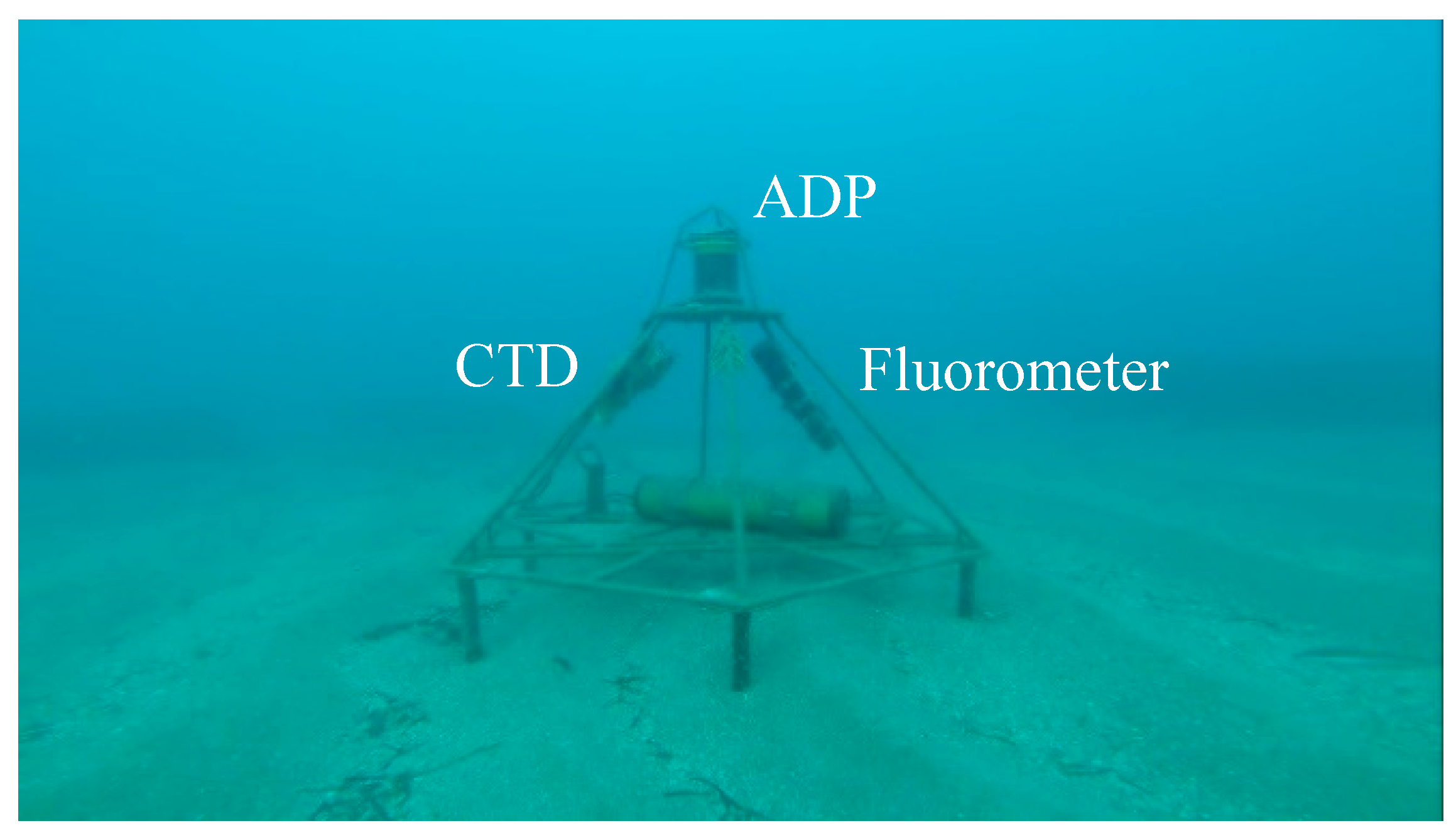
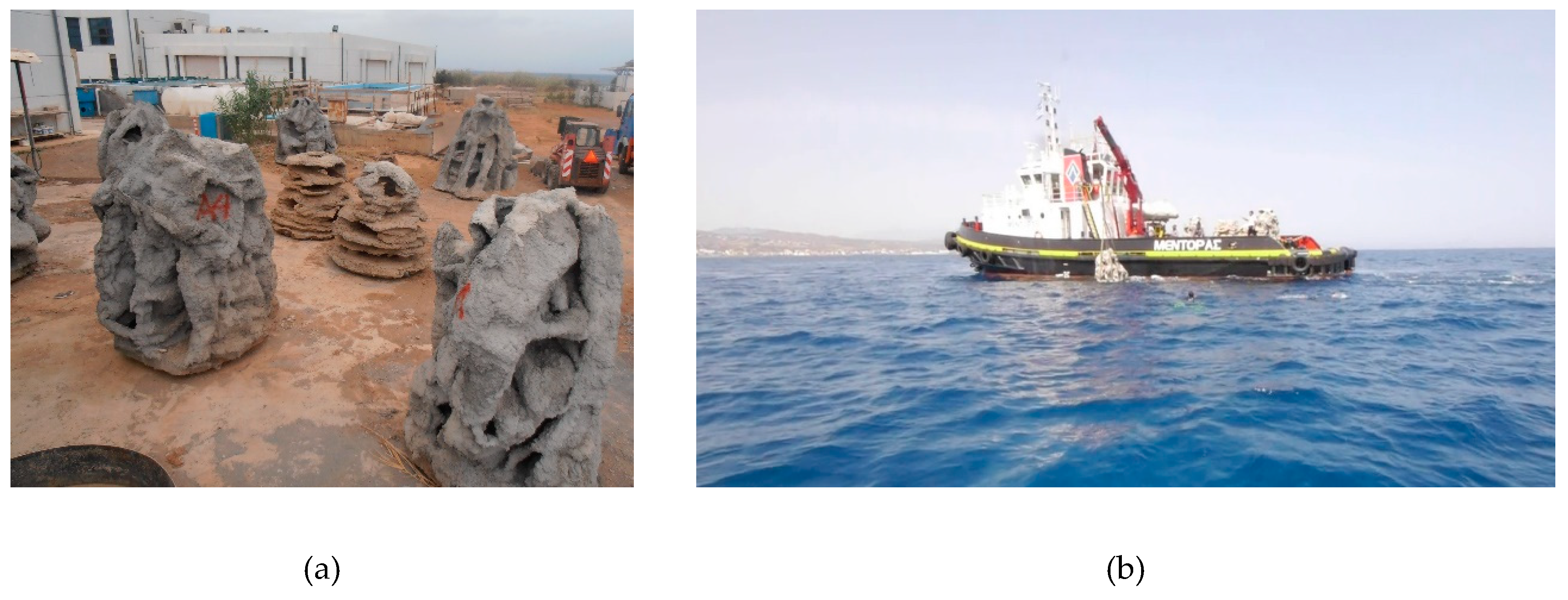
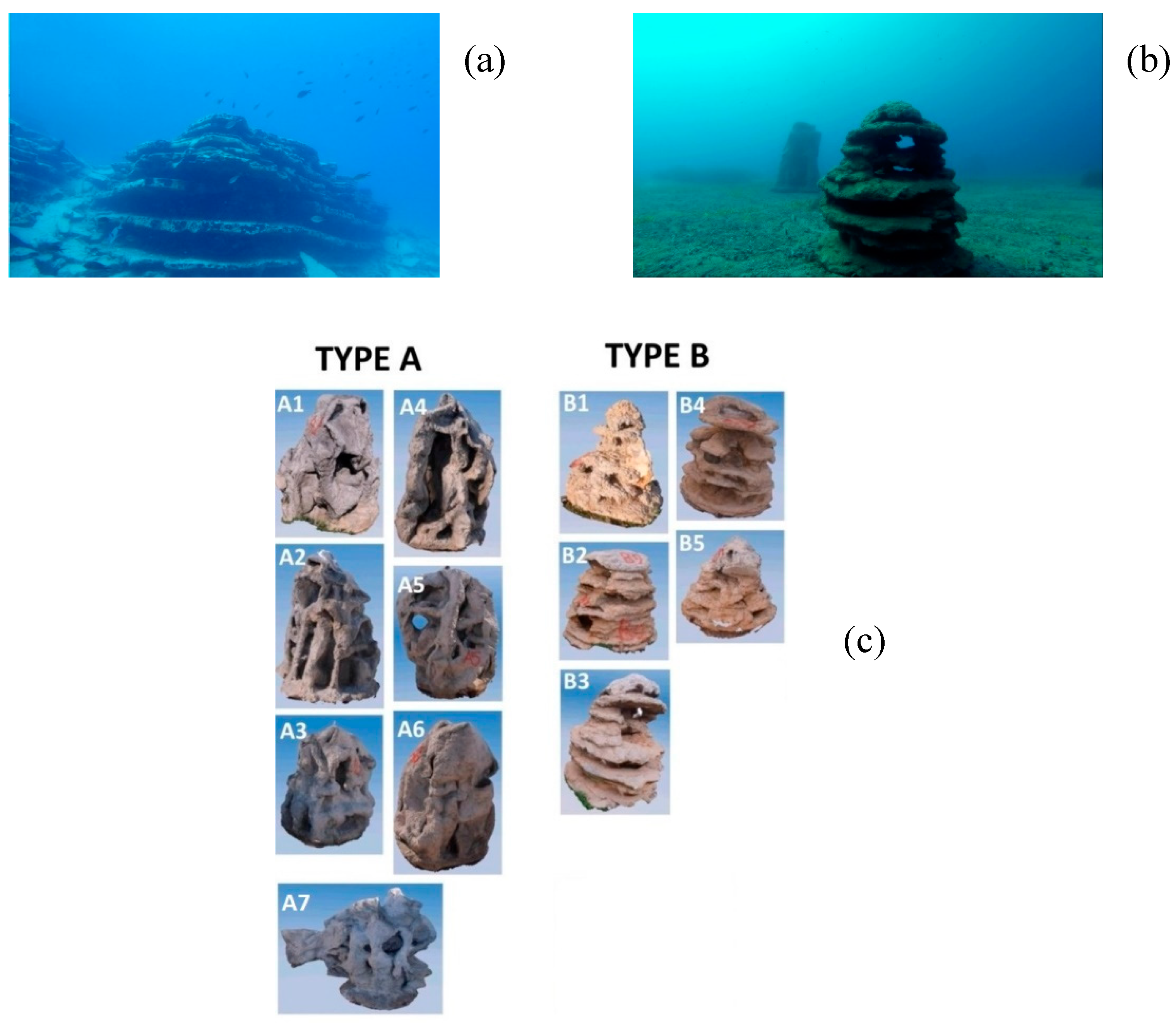

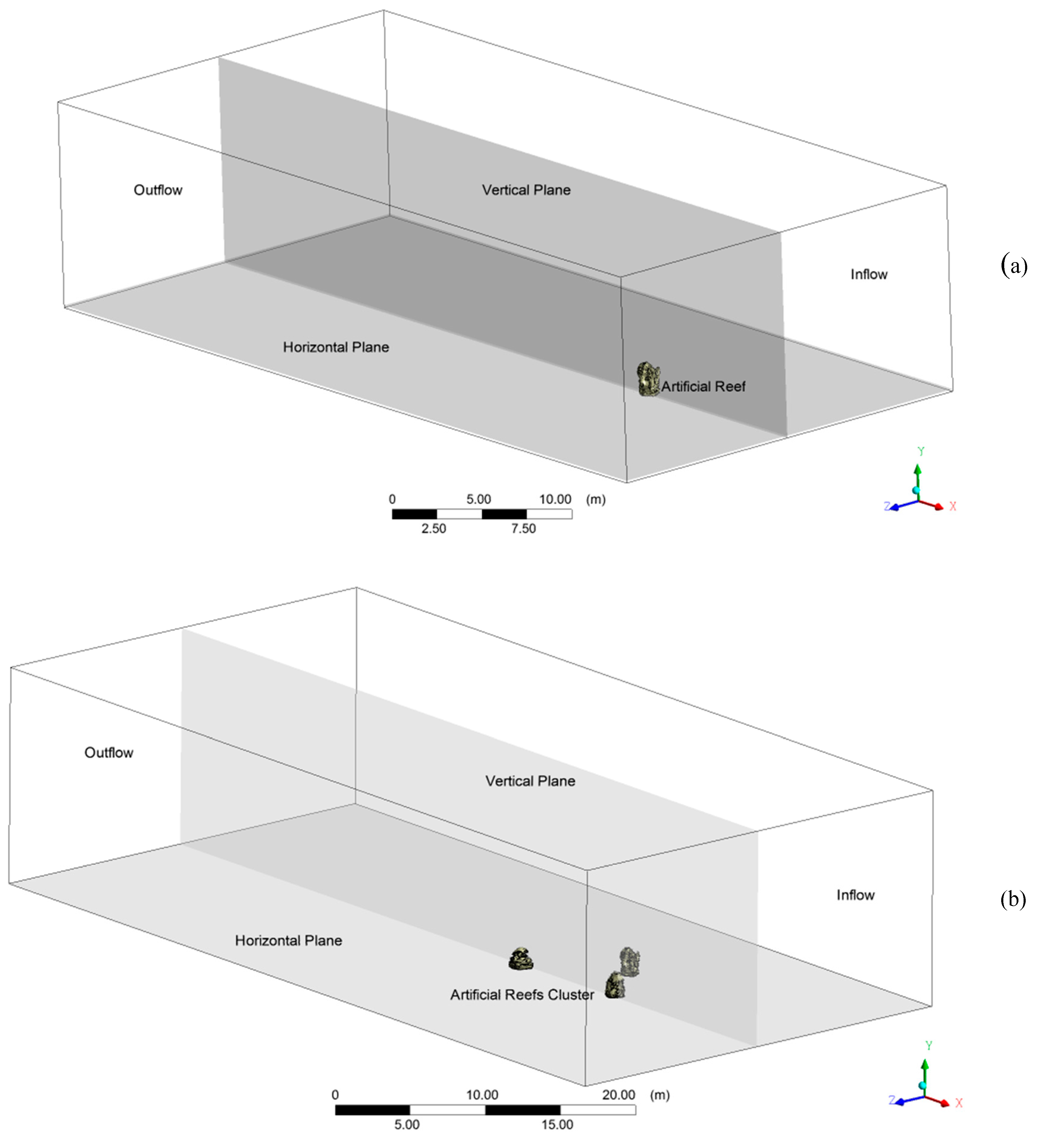
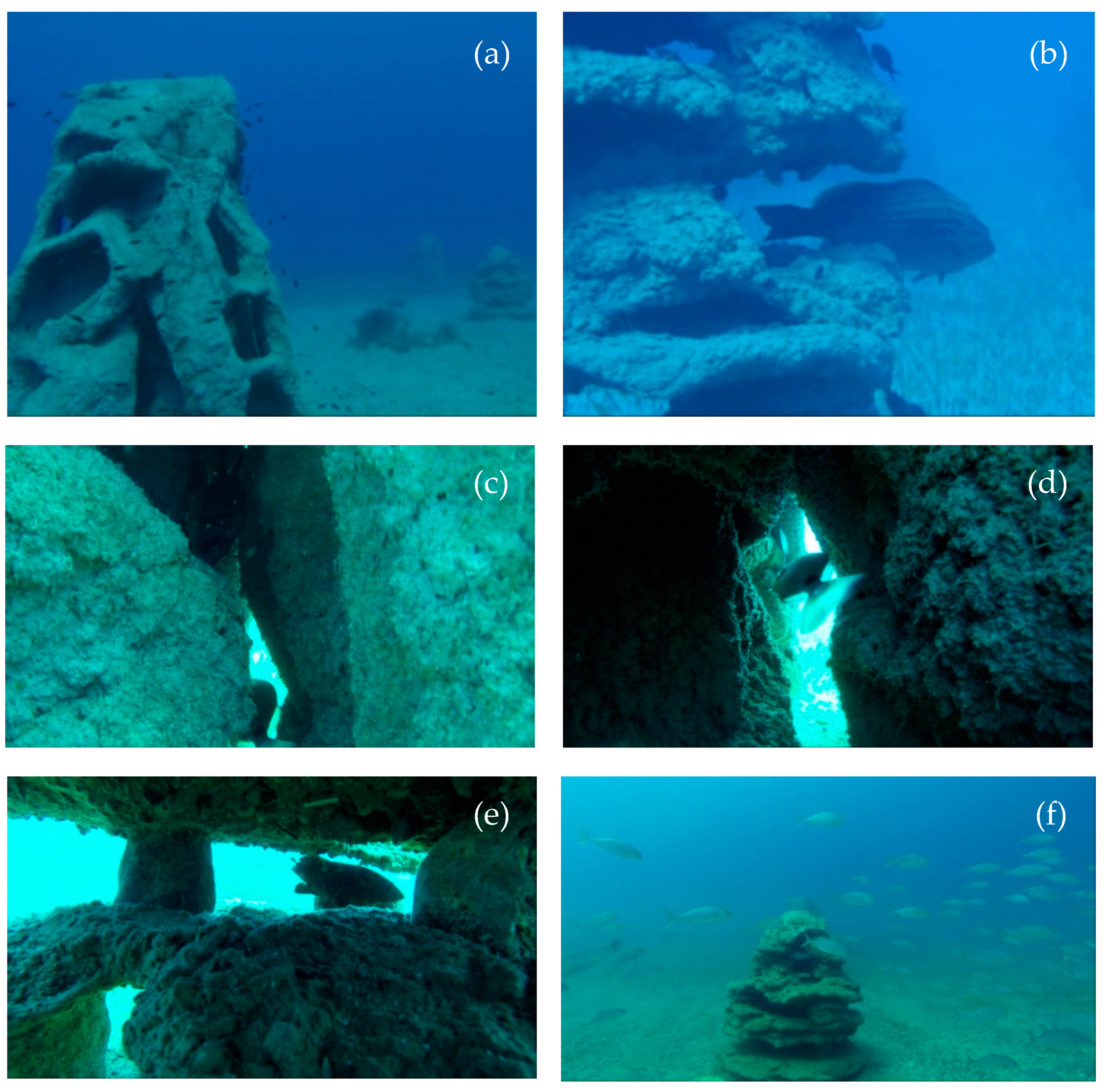
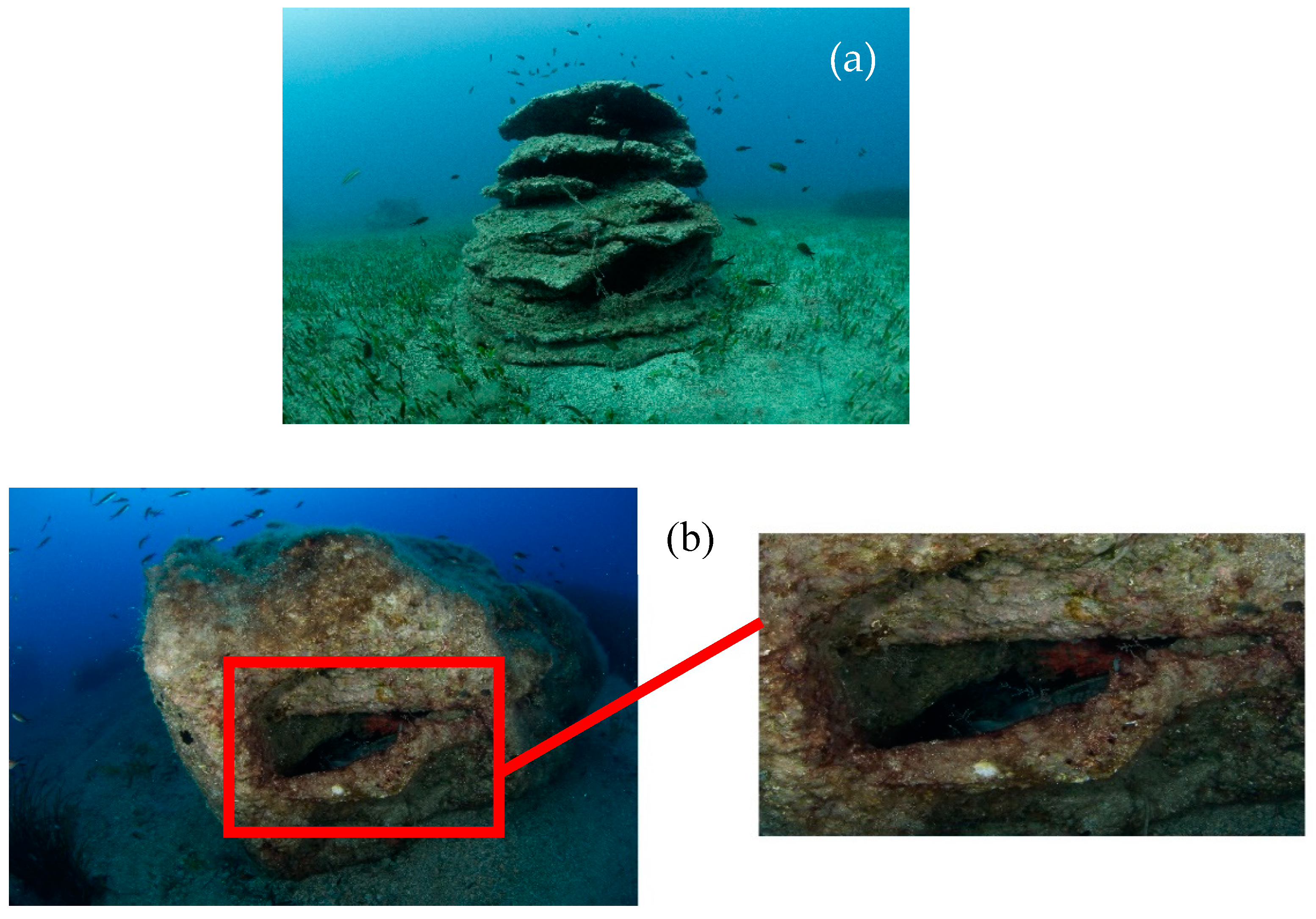

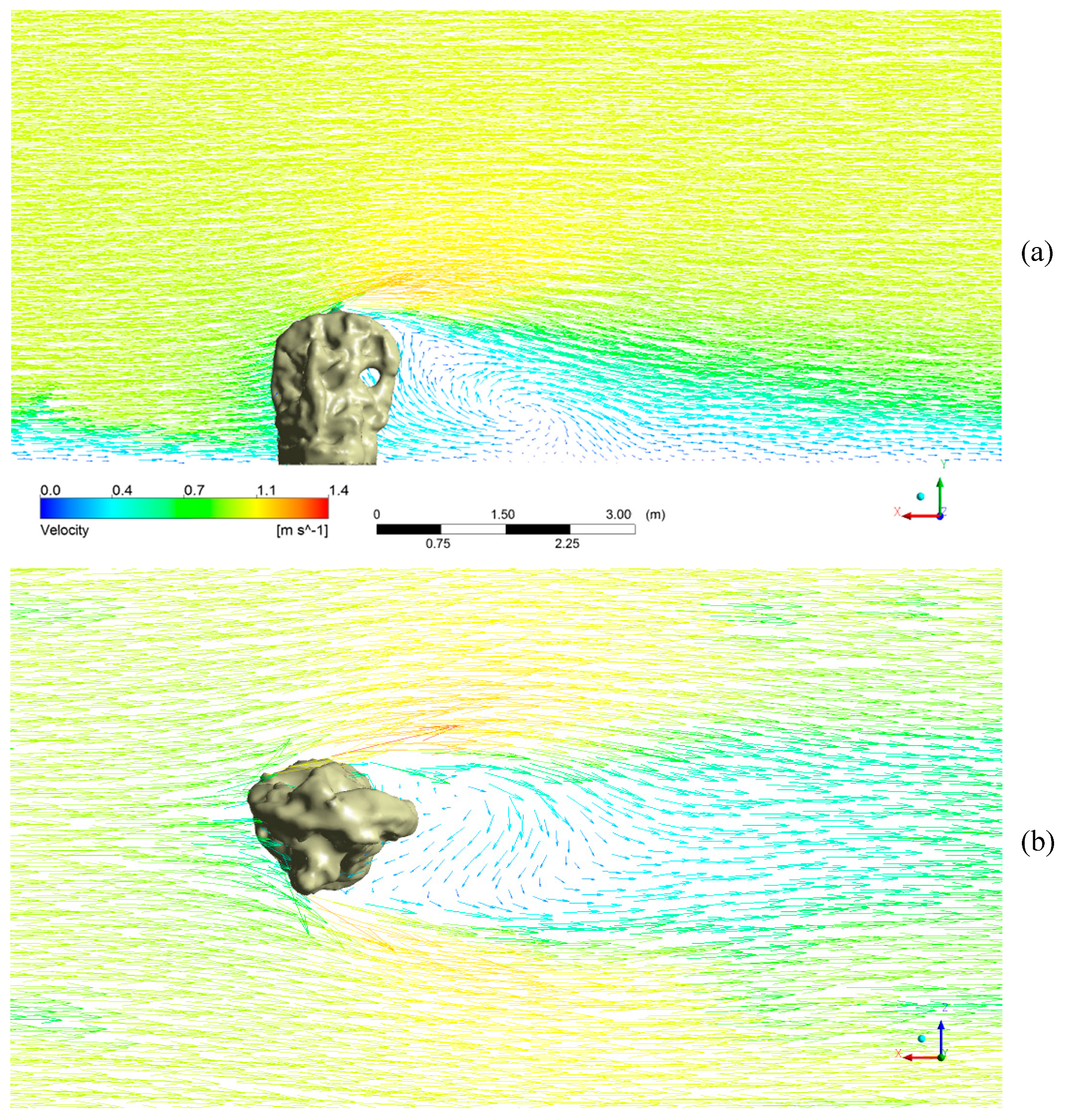
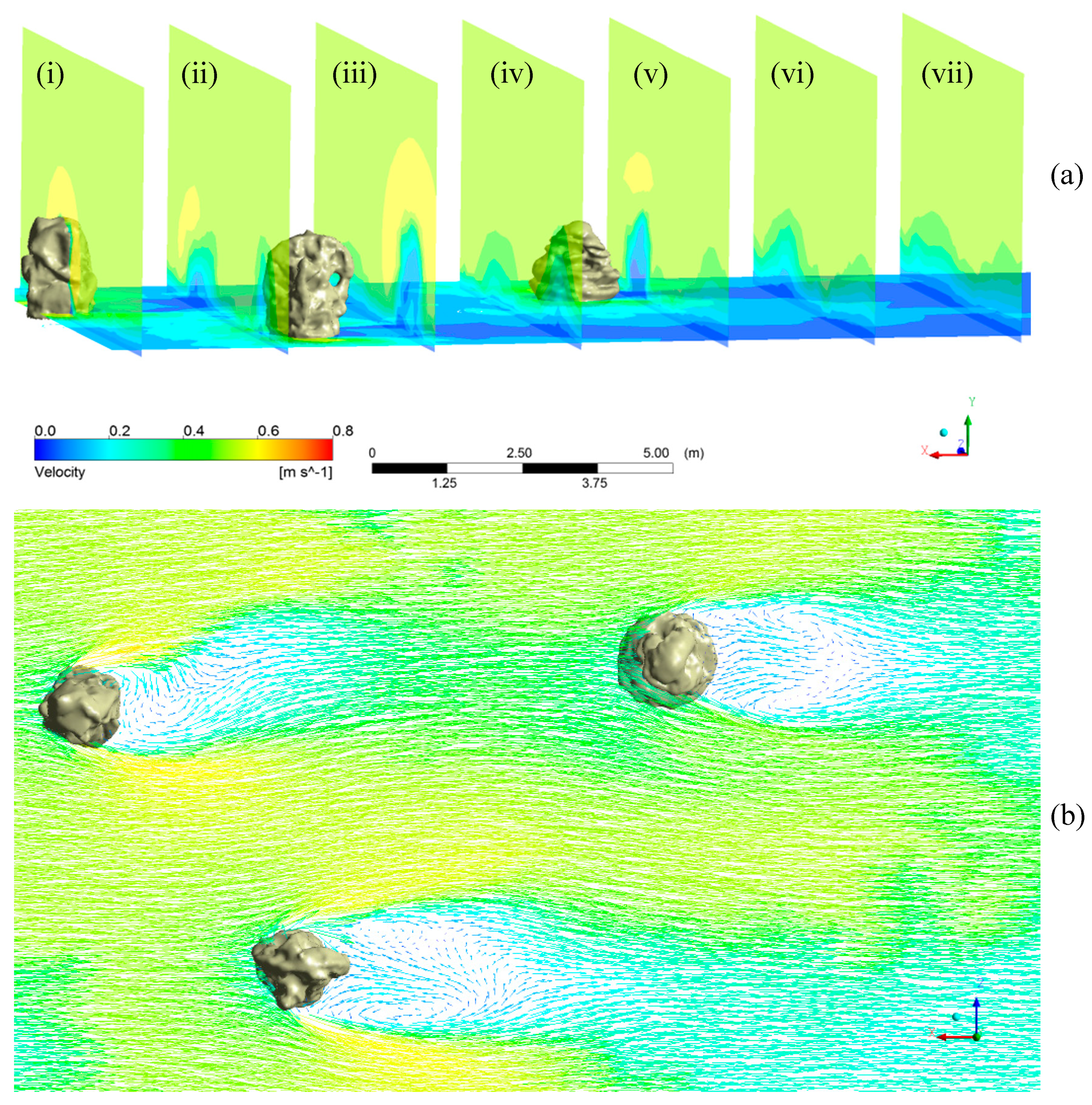
© 2020 by the authors. Licensee MDPI, Basel, Switzerland. This article is an open access article distributed under the terms and conditions of the Creative Commons Attribution (CC BY) license (http://creativecommons.org/licenses/by/4.0/).
Share and Cite
Androulakis, D.N.; Dounas, C.G.; Banks, A.C.; Magoulas, A.N.; Margaris, D.P. An Assessment of Computational Fluid Dynamics as a Tool to Aid the Design of the HCMR-Artificial-ReefsTM Diving Oasis in the Underwater Biotechnological Park of Crete. Sustainability 2020, 12, 4847. https://doi.org/10.3390/su12124847
Androulakis DN, Dounas CG, Banks AC, Magoulas AN, Margaris DP. An Assessment of Computational Fluid Dynamics as a Tool to Aid the Design of the HCMR-Artificial-ReefsTM Diving Oasis in the Underwater Biotechnological Park of Crete. Sustainability. 2020; 12(12):4847. https://doi.org/10.3390/su12124847
Chicago/Turabian StyleAndroulakis, Dimitrios N., Costas G. Dounas, Andrew Clive Banks, Antonios N. Magoulas, and Dionissios P. Margaris. 2020. "An Assessment of Computational Fluid Dynamics as a Tool to Aid the Design of the HCMR-Artificial-ReefsTM Diving Oasis in the Underwater Biotechnological Park of Crete" Sustainability 12, no. 12: 4847. https://doi.org/10.3390/su12124847
APA StyleAndroulakis, D. N., Dounas, C. G., Banks, A. C., Magoulas, A. N., & Margaris, D. P. (2020). An Assessment of Computational Fluid Dynamics as a Tool to Aid the Design of the HCMR-Artificial-ReefsTM Diving Oasis in the Underwater Biotechnological Park of Crete. Sustainability, 12(12), 4847. https://doi.org/10.3390/su12124847






